
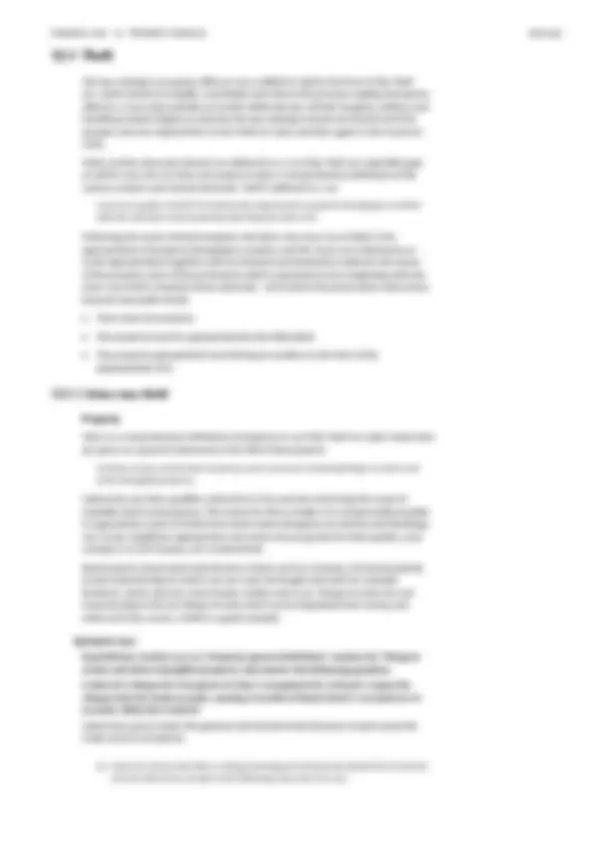
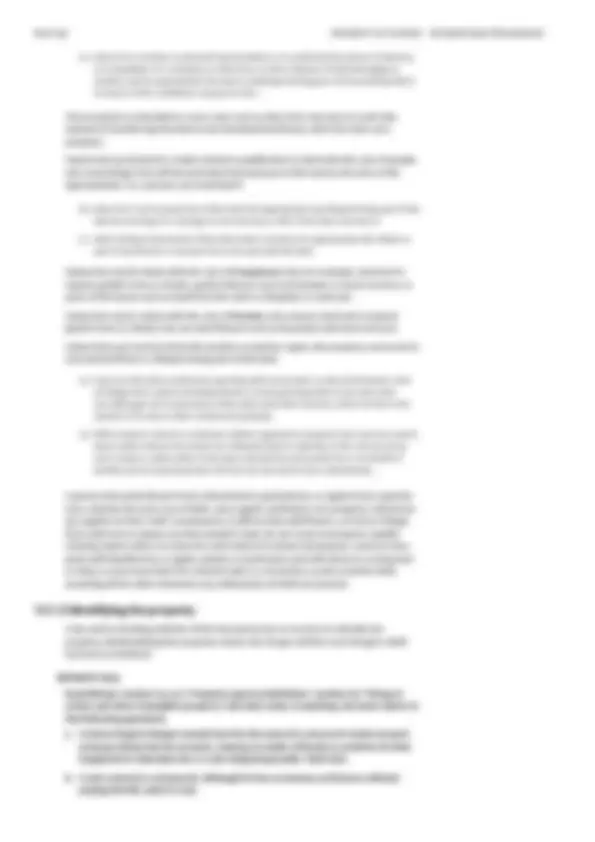
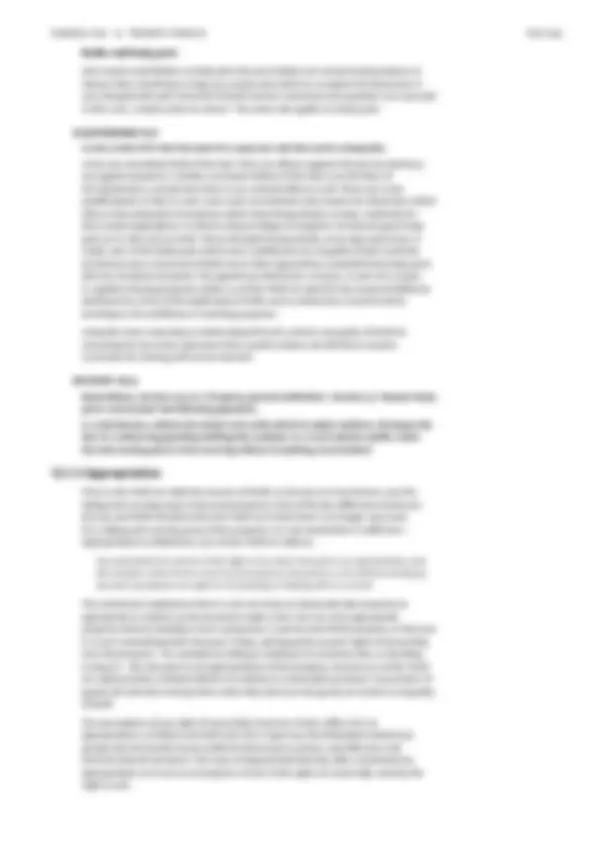
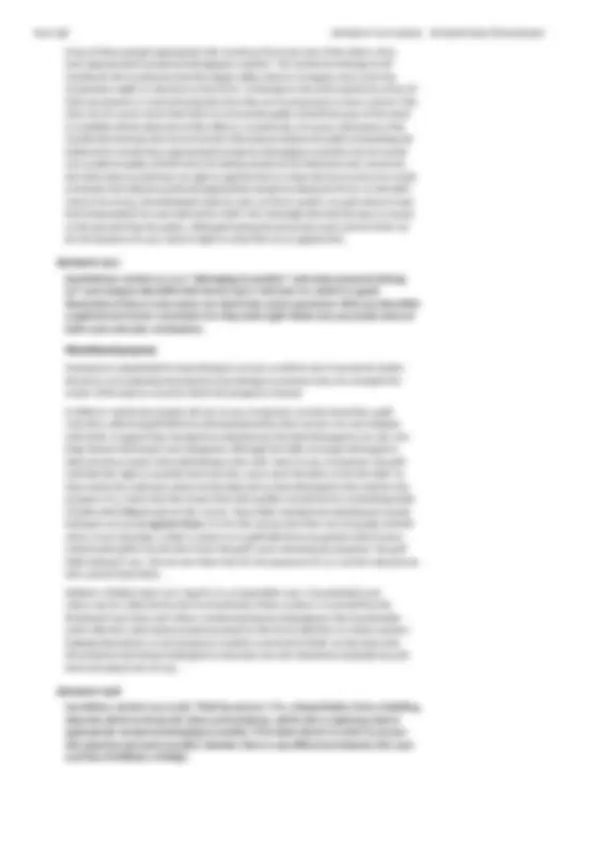
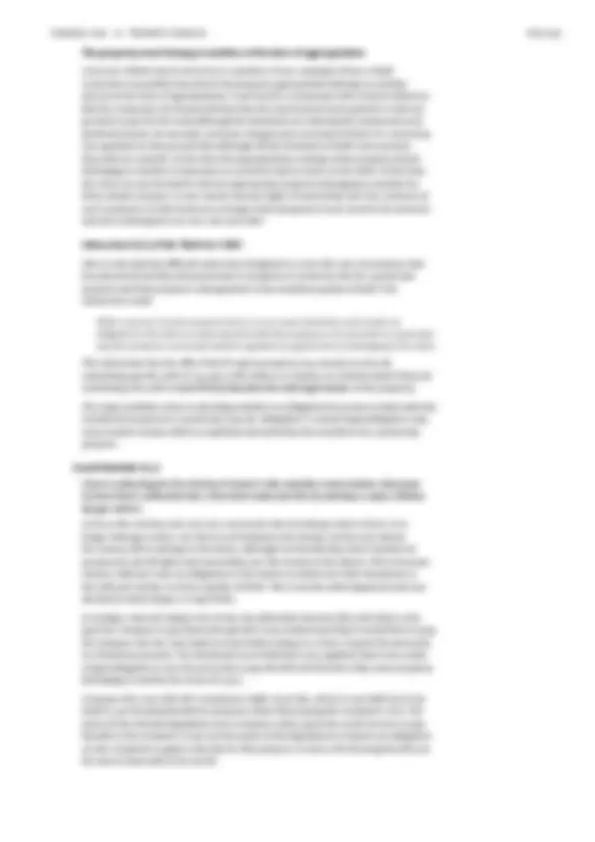
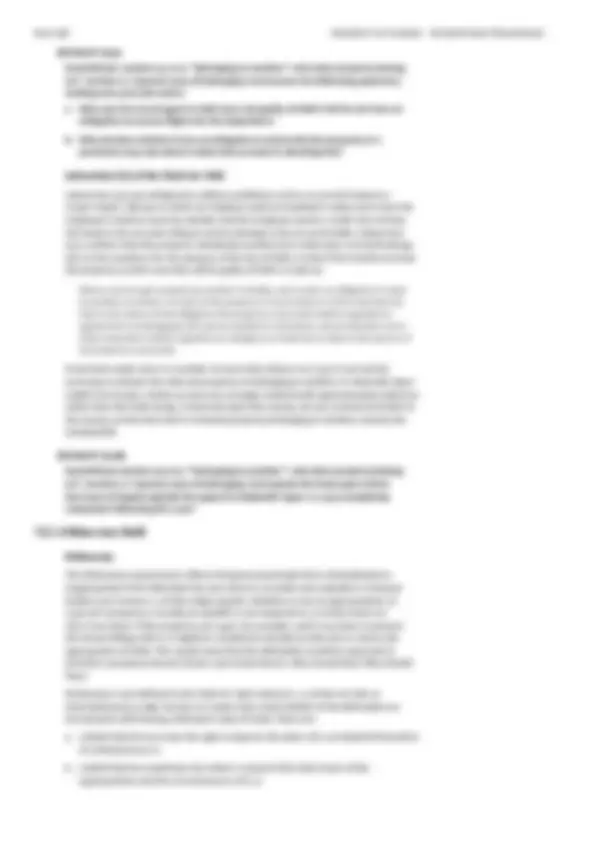
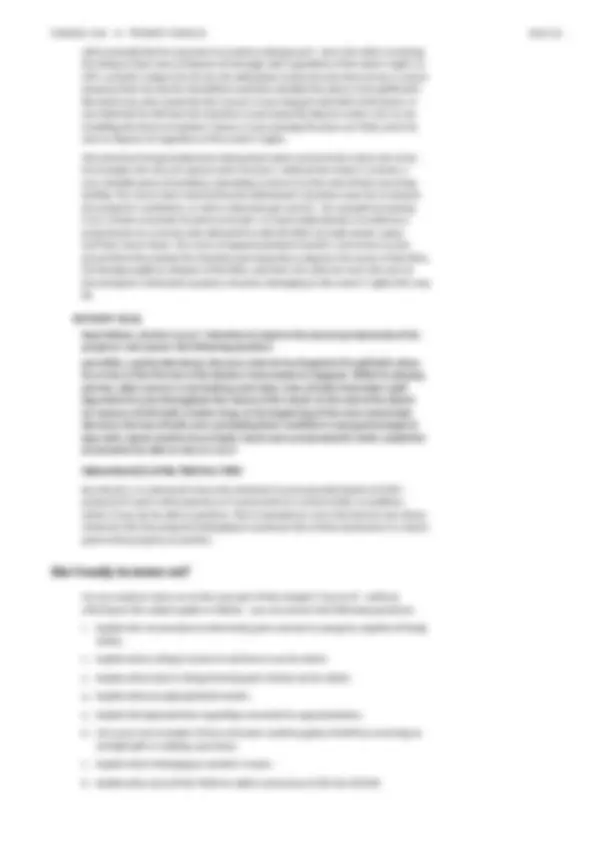
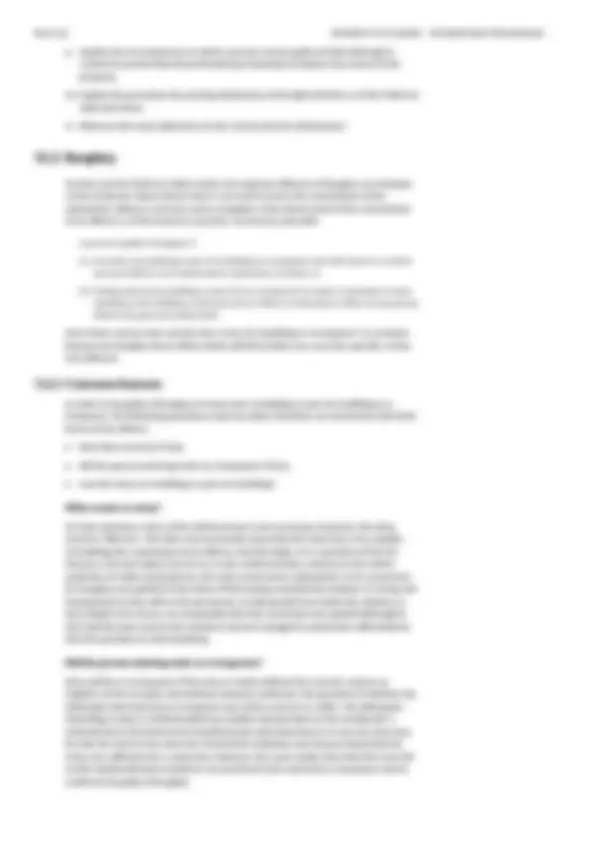
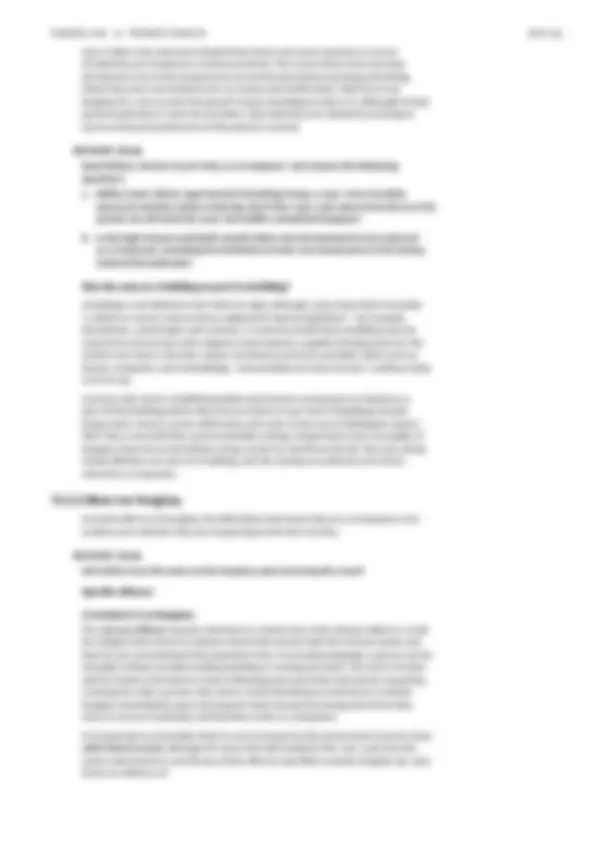
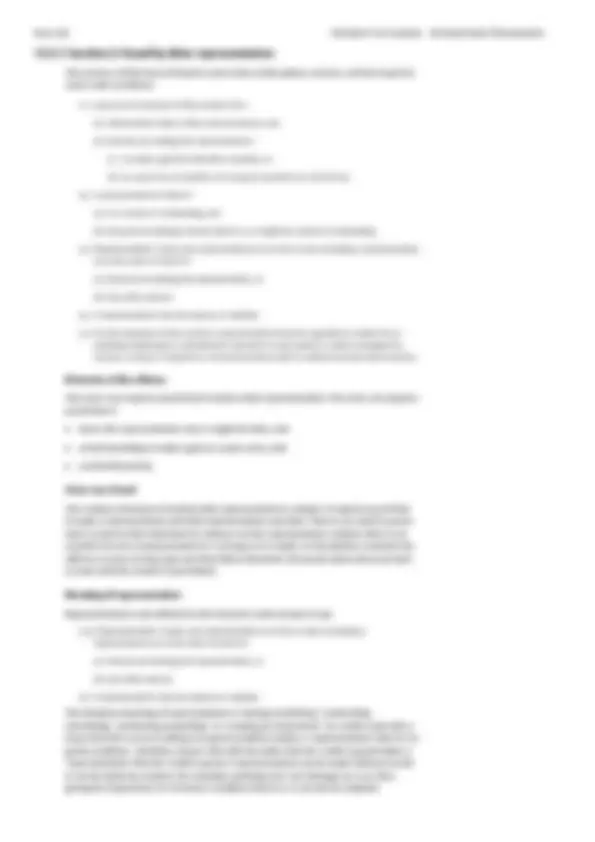
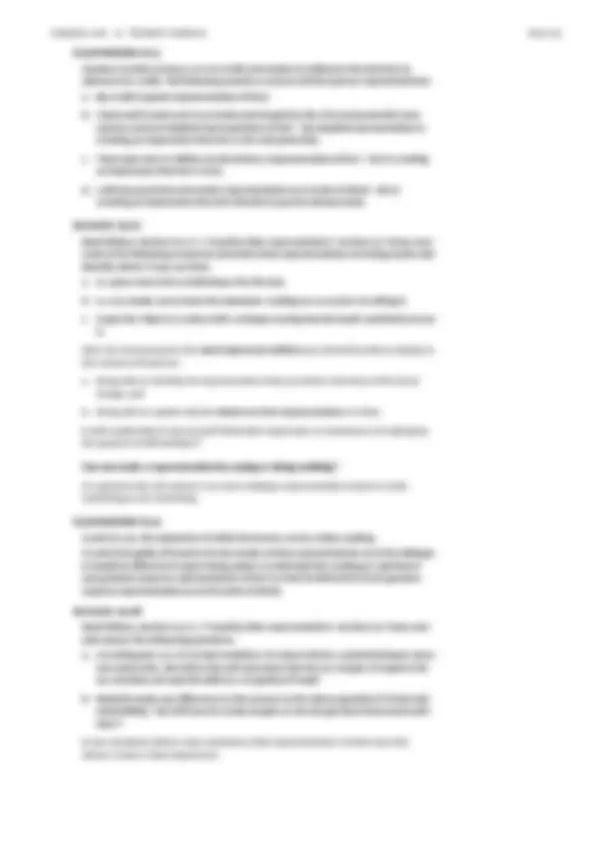
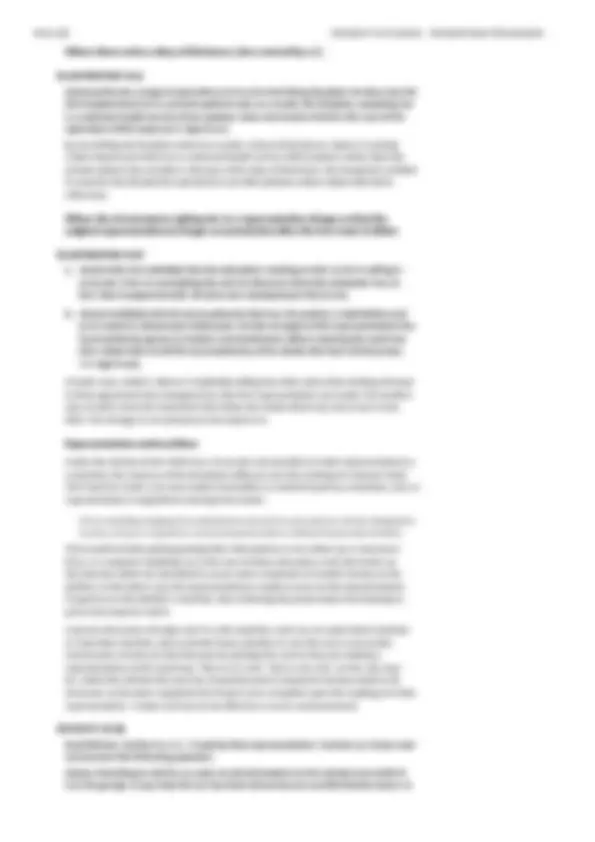
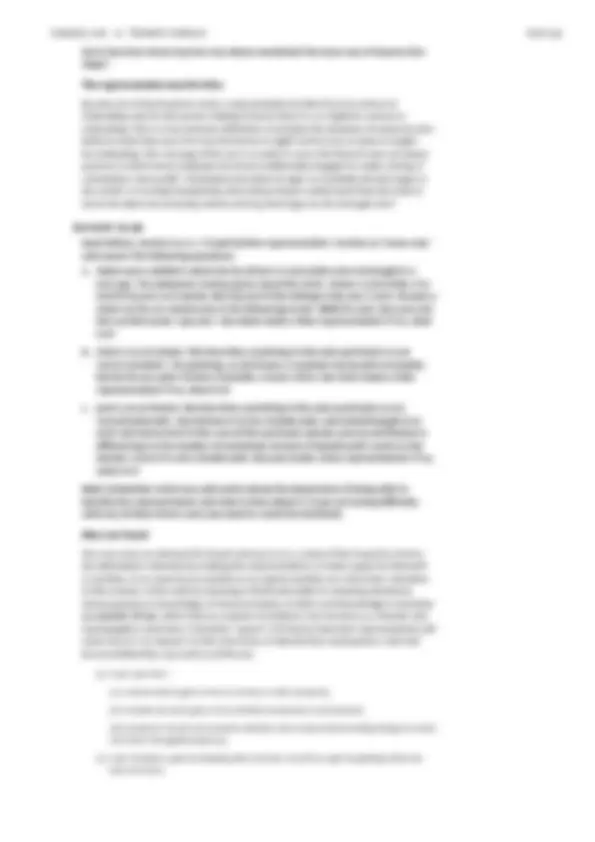
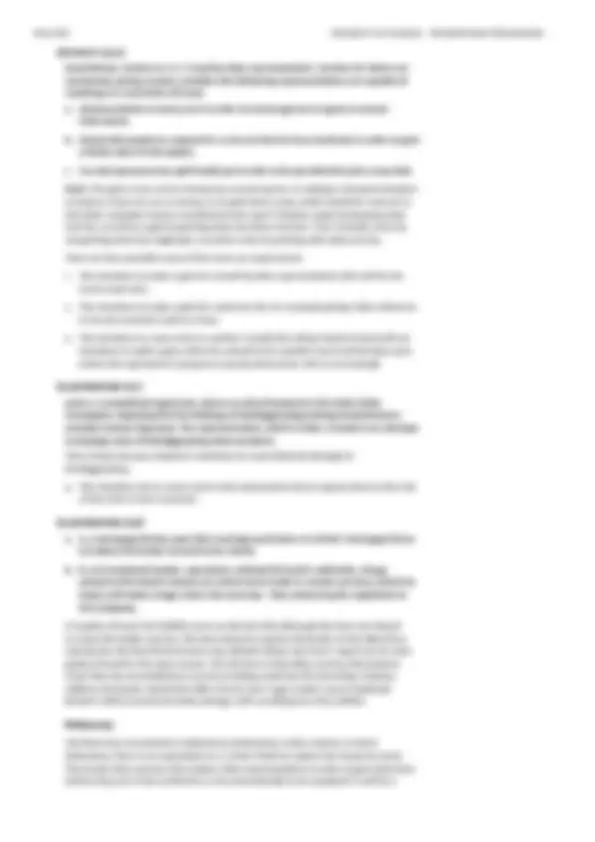
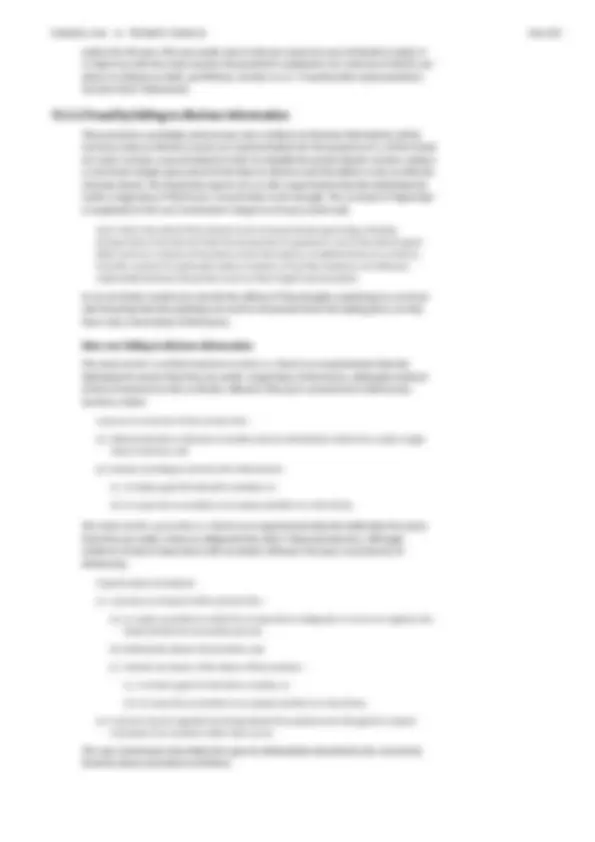
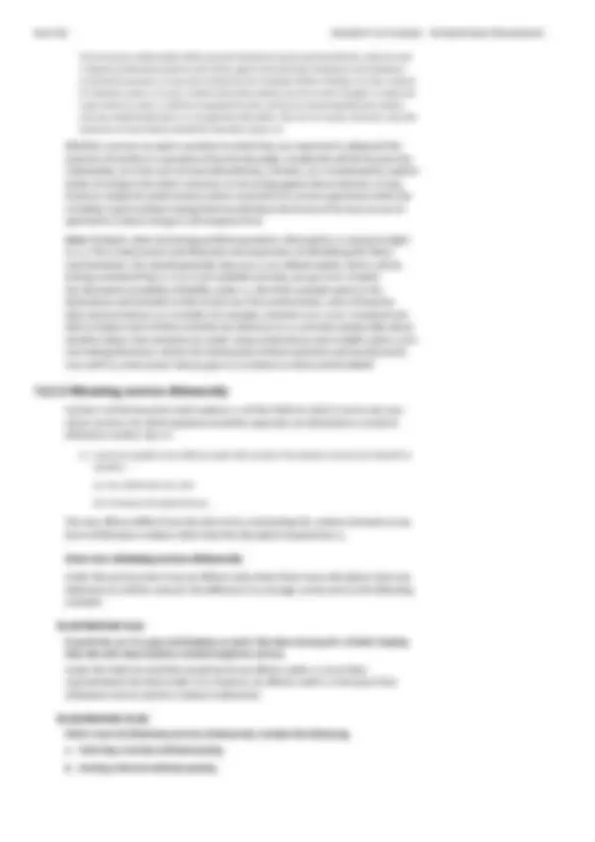
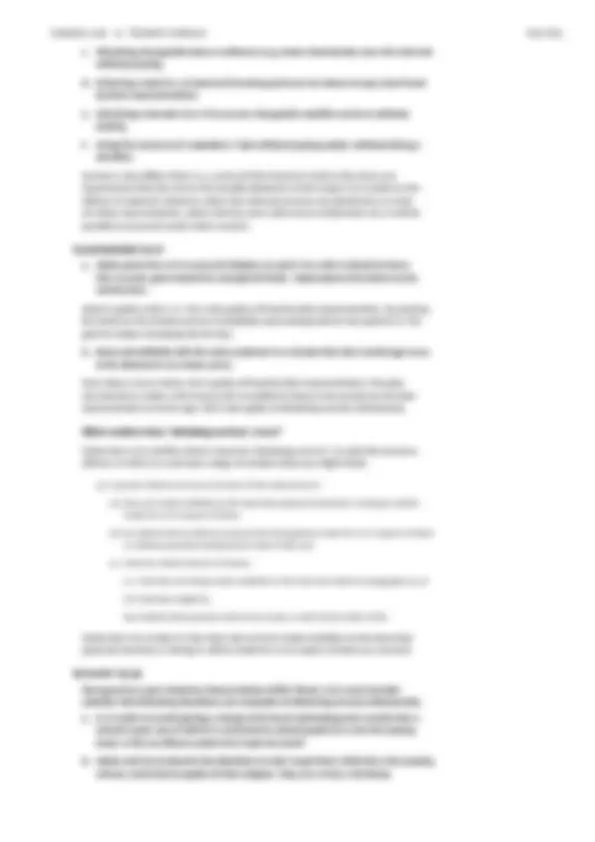
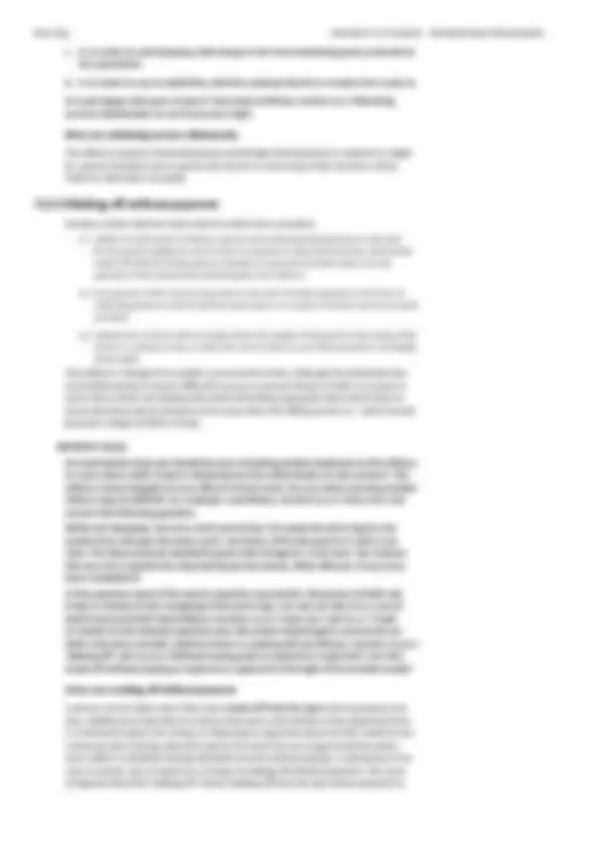
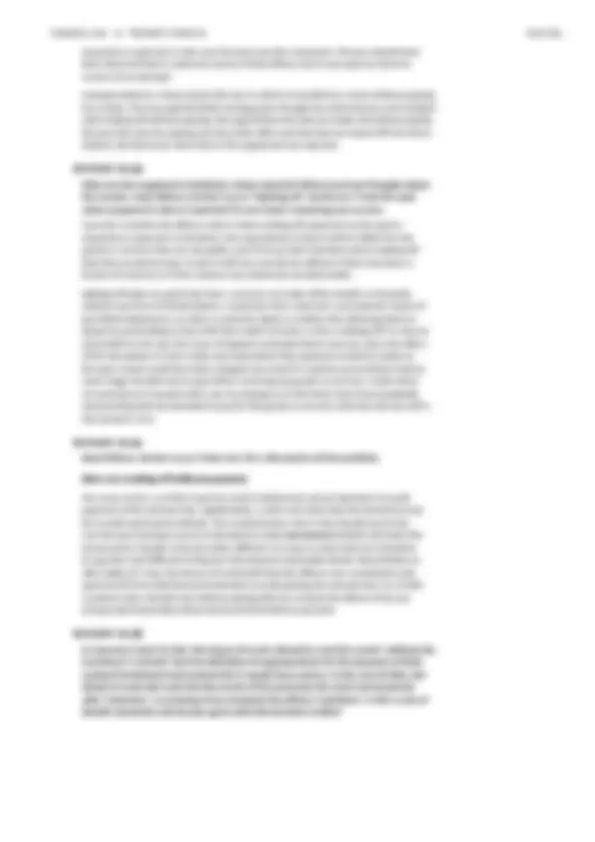
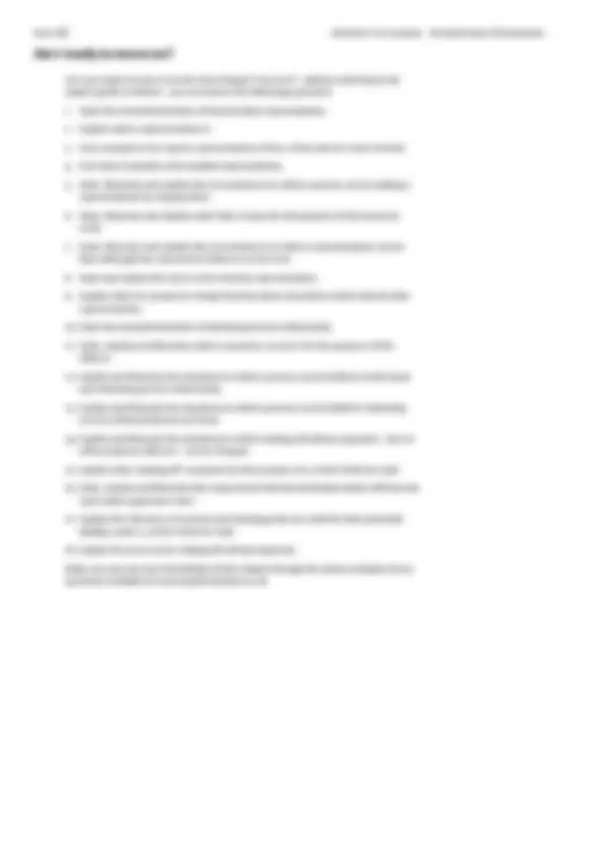


Study with the several resources on Docsity

Earn points by helping other students or get them with a premium plan


Prepare for your exams
Study with the several resources on Docsity

Earn points to download
Earn points by helping other students or get them with a premium plan
Community
Ask the community for help and clear up your study doubts
Discover the best universities in your country according to Docsity users
Free resources
Download our free guides on studying techniques, anxiety management strategies, and thesis advice from Docsity tutors
Following the usual criminal template, therefore, the actus reus of theft is the appropriation of property belonging to another; and the mens rea is dishonesty ...
Typology: Study notes
1 / 28

This page cannot be seen from the preview
Don't miss anything!





















(a) when he is a trustee or personal representative, or is authorised by power of attorney, or as liquidator of a company, or otherwise, to sell or dispose of land belonging to another, and he appropriates the land or anything forming part of it by dealing with it in breach of the confidence reposed in him… This exception is intended to cover cases such as that of an executor of a will who, instead of transferring the land to the intended beneficiary, sells it for their own purposes. Subsections 4(2)(b)and (c) make a further qualification to deal with the case of people who steal things from off the land which formed part of the land at the time of the appropriation. So, a person can steal land if: (b) when he is not in possession of the land [he] appropriates anything forming part of the land by severing it or causing it to be severed, or after it has been severed; or (c) when, being in possession of the land under a tenancy, he appropriates the whole or part of any fixture or structure let to be used with the land. Subsection 4(2)(b) deals with the case of trespassers who, for example, steal turf or topsoil, garden trees or shrubs, garden fixtures such as fountains or stone terraces, or parts of the house such as lead from the roof or a fireplace or staircase. Subsection 4(2)(c) deals with the case of tenants , who cannot steal turf or topsoil, garden trees or shrubs, but can steal fixtures such as fountains and stone terraces. Subsections 4(3) and (4) deal with another exception. Again, the property concerned is not land itself but is a thing forming part of the land. (3) A person who picks mushrooms growing wild on any land, or who picks flowers, fruit or foliage from a plant [including shrubs or trees] growing wild on any land, does not (although not in possession of the land) steal what he picks, unless he does it for reward or for sale or other commercial purpose. (4) Wild creatures, tamed or untamed, shall be regarded as property; but a person cannot steal a wild creature not tamed nor ordinarily kept in captivity, or the carcase of any such creature, unless either it has been reduced into possession by or on behalf of another person and possession of it has not since been lost or abandoned… A person who picks flowers from a flowerbed or greenhouse, or apples from a garden tree commits the actus reus of theft, since apples and flowers are property. Subsection 4(3) applies to their ‘wild’ counterparts. It affirms that wild flowers, or fruit or foliage from wild trees or plants on other people’s land, do not count as property capable of being stolen unless it is done for some kind of commercial purpose. A person who picks wild blackberries or apples, plants or mushrooms and sells them to a restaurant or shop, or processes them for onward trade, is covered by s.4 and commits theft, assuming all the other elements (e.g. dishonesty) of theft are present. 12.1.2 Identifying the property A key task in deciding whether theft of property has occurred is to identify the property. Misidentifying the property means the charge will fail, even though a theft has been committed.
Read Wilson, Section 14.2.A.2 ‘Property: general definition’, Section (b) ‘Things in action and other intangible property’ and state what, if anything, has been stolen in the following questions. a. A draws forged cheques owned by B for the sum of £1,000 on B’s bank account and pays them into his account, causing a transfer of funds (a variation of what happened in Chan Man-Sin v A-G for Hong Kong [1988] 1 WLR 196). b. A eats a meal in a restaurant, although he has no money, and leaves without paying the bill, which is £20.
One cannot steal bodies or body parts because bodies are not personal property. In Sharpe (1857) 169 ER 959, D dug up a corpse and sold it to a surgeon for dissection. D was charged with and convicted of theft, but his conviction was quashed. As it was said in this case, ‘a body wants no owner’. The same rule applies to body parts.
A cuts a lock of B’s hair because B is a pop star and she wants a keepsake. A has not committed theft of the hair. This is an offence against the person (battery), not against property. A similar conclusion follows if the hair is on the floor of the hairdressers, except here there is no criminal offence at all. There are some qualifications to this to cover cases such as mummies and corpses for dissection which take on the properties of property rather than being simply a corpse. Authority for this is Kelly [1999] QB 621, in which a Royal College of Surgeons’ technician gave body parts to D, who was an artist. These included human heads, arms, legs and torsos. D made casts of the body parts which were exhibited in an art gallery. Both D and the technician were convicted of theft, but in their appeal they contended the body parts did not constitute property. The appeal was dismissed. A corpse, or part of a corpse, is capable of being property within s.4 of the Theft Act 1968 if it has acquired different attributes by virtue of the application of skill, such as dissection or preservation techniques, for exhibition or teaching purposes. Using the same reasoning, in Welsh [1974] RTR 478, a driver was guilty of theft for removing his own urine specimen from a police station. He did this to avoid a conviction for driving with excess alcohol.
Read Wilson, Section 14.2.A.2 ‘Property: general definition’, Section (a) ‘Human body parts’ and answer the following question. A, a hairdresser, collects his client’s hair with which to make cushions. He keeps the hair in a refuse bag pending stuffing the cushions. B, a rival cushion stuffer, takes the hair, having put it in her own bag. What, if anything, has B stolen? 12.1.3 Appropriation Prior to the Theft Act 1968 the essence of theft, or larceny as it was known, was the taking and carrying away of personal property. (One of the key differences between larceny and theft introduced by the Theft Act is that there is no longer any need for a taking and carrying away of the property. It is not needed but is sufficient.) Appropriation is defined by s.3(1) of the Theft Act 1968 as: Any assumption by a person of the rights of an owner amounts to an appropriation, and this includes, where he has come by the property (innocently or not) without stealing it, any later assumption of a right to it by keeping or dealing with it as owner. This statement emphasises that it is not necessary to physically take property to appropriate it. Indeed, as the provision makes clear, one can even appropriate property which is lawfully in one’s possession. A person who finds property, or borrows it, is not committing theft. However, if they subsequently assume rights of ownership over the property – for example by selling it, lending it to someone else, or deciding to keep it – this amounts to an appropriation of the property. Section 3(2) of the Theft Act 1968 provides a limited defence in relation to a bona fide purchaser. A purchaser of goods who decides to keep them when they discover the goods are stolen is not guilty of theft. The assumption of any right of ownership, however trivial, suffices for an appropriation. In Pitham and Hehl (1977) 65 Cr App R 45, the defendant invited two people into his friend’s house while his friend was in prison, and offered to sell them his friend’s furniture. The Court of Appeal held that this offer constituted an appropriation as it was an assumption of one of the rights of ownership, namely the right to sell.
Note that in Gomez it was D, not R, who was charged with theft. What had D done to appropriate the property? In Gomez , the transfer was defective because the shop manager’s consent was obtained by fraud and so the transfer of ownership could be undone. Does the person who induces the transfer also appropriate property where there has been no fraud and where the transferee receives an absolute title to the property? This was the question the House of Lords had to answer in Hinks [2001] 2 AC 241. In this case D had befriended V, a naive and gullible man, and encouraged him to make her gifts of money from his bank account. She was convicted of theft, although there was no evidence of duress or deception, or that V had parted with the money otherwise than by gift. The defence case was that the recipient of a valid gift could not be guilty of theft. Either there is a valid transfer of title or there is an appropriation. There cannot be both. Lord Steyn said that whether or not V had gifted the money, D, by acquiring title, had appropriated it. The acquisition of title, on this view, is simply the clearest possible case of ‘assuming rights of ownership’. This was a surprising decision because the transfer was treated as valid by the civil law – V could not claim the money back in the civil courts as it was a perfect gift – but it was an invalid transfer by the criminal law. D was guilty of stealing the money, assuming her obtaining of the money was thought to be dishonest. The same principle applies to other transactions involving the transfer of ownership such as contracts for sale ( Gomez ).
The House of Lords made it clear that most people who received property by way of gift would not be guilty of theft. Liability in such a case will depend upon whether D was dishonest in receiving the gift. Most receivers of gifts are not – thank goodness! Now read Wilson Section 14.2.B.2 ‘Dishonesty’ and decide whether Mrs Hinks was dishonest in receiving her gift and how the court approached the question of dishonesty. Once you have done that you might wish to read the dissenting opinion of Lord Hobhouse who, however immoral you think Mrs Hinks was, is surely right in concluding that she was not. You will find Hinks in the Online Library.
A person cannot be guilty of theft if the property they appropriate does not belong to another person. But a person can be guilty of theft if they appropriate property that belongs to them! How can this be? The answer to this question is to be found in s.5 of the Theft Act 1968 which defines the term ‘belonging to another’. Section 5(1) states that property belongs to ‘any person having possession or control of it, or having in it any proprietary right or interest’. The consequence of this rather puzzling subsection is that a person can commit theft of their own property so long as it also belongs to someone else for the purpose of s.5. To understand this section properly let us assume that the property is a racehorse, which is owned by a Mr Southwell. For the purpose of the Theft Act 1968 the racehorse belongs to: u Mr Southwell u Mrs Goodwood, part owner u Ms Lingfield, the owner of the stables where the racehorse is stabled u Mr Aintree, the jockey, when he takes the horse for a gallop (during the gallop) u Mr Doncaster, the blacksmith, to whom the horse is delivered for a few hours to be shod (during those hours) u Mrs Wincanton, the owner’s friend, to whom he lends the horse to compete in a race (during the loan period) u The Happy Valley Finance Company, who lends Mr Southwell £50,000, using the horse as security.
If any of these people appropriate the racehorse from any one of the others, they have appropriated ‘property belonging to another’. The racehorse belongs to Mr Southwell, Mrs Goodwood and the Happy Valley Finance Company since each has ‘proprietary rights or interests in the horse’. It belongs to the other parties by virtue of their possession or control during the time they are in possession or have control. This does not of course mean that they are necessarily guilty of theft because of the need to establish all the elements of the offence, in particular, of course, dishonesty. If Mr Southwell took back the horse from Mrs Wincanton without formally terminating the bailment he would have appropriated property belonging to another, but he would not usually be guilty of theft since his taking would not be dishonest and, moreover, Mrs Wincanton would have no right as against him to retain the horse and so he could terminate the bailment perfectly legitimately simply by taking the horse. In Meredith [1973] Crim LR 253, the defendant took his own car from a police car park where it had been impounded. He was indicted for theft. The trial judge directed the jury to acquit on the ground that the police, although having the possession and control of the car for the purpose of s.5(1), had no right to retain the car as against him.
Read Wilson, Section 14.2.A.3 ‘“Belonging to another”: who does property belong to?’ and compare Meredith with Turner [1971] 1 WLR 901 CA, which is a good illustration of how a true owner can steal from a mere possessor. Why was Meredith acquitted and Turner convicted? Are they both right? Make sure you make notes of both cases and your conclusions.
If property is abandoned it may belong to no one, in which case it cannot be stolen. However, even abandoned property may belong to someone else, for example the owner of the land or vessel in which the property is found. In Hibbert v McKiernan [1948] 2 KB 142, D was a trespasser on land owned by a golf club who collected golf balls lost and abandoned by their owners. He was charged with theft. D argued that, having been abandoned, the balls belonged to no one: the King’s Bench Divisional Court disagreed. Although the balls no longer belonged to their previous owners they did belong to the club. Since D was a trespasser, the golf club had the right to exclude him from the course and, therefore, from the balls. To that extent the club had control of the balls and so they belonged to the club for the purpose of s.5. Note that this means that other golfers would not be committing theft of balls which they found on the course. These balls, having been abandoned, would belong to no one as against them. It is for this reason also that I am not guilty of theft when, every Saturday, I collect a dozen or so golf balls from my garden which some unfortunate golfer has hit there from the golf course abutting my property. The golf balls belong to me. I do not own them but, for the purposes of s.5, I am the only person who cannot steal them. Williams v Phillips (1957) 41 Cr App R 5 is a comparable case. A householder put refuse out for collection by the local authority refuse workers. It was held by the Divisional Court that such refuse remained property belonging to the householder until collected, whereupon property passed to the local authority. So refuse workers helping themselves to such property could be convicted of theft, on the basis that the property had always belonged to someone (see also Woodman [1974] QB 754 and Hancock [1990] Crim LR 125).
See Wilson, Section 14.2.A.3(b) ‘Theft by owners’. If A, a householder, hires a building skip into which to throw her doors and windows, which she is replacing, does B appropriate ‘property belonging to another’ if he takes them? In order to answer this question you must consider whether there is any difference between this case and that of Williams v Phillips****.
Read Wilson, Section 14.2.A.3 ‘“Belonging to another”: who does property belong to?’, Section (c) ‘Special cases of belonging’ and answer the following questions, making sure you take notes! a. Why was the travel agent in Hall (1972) not guilty of theft? Did he not have an obligation to secure flights for the depositors? b. Who decides whether D has an obligation to deal with the property in a particular way and what is taken into account in deciding this?
Subsection 5(4) was designed to address problems such as occurred in Moynes v Cooper [1956] 1 QB 439, in which an employer paid an employee’s salary twice into the employee’s bank account by mistake and the employee spent it. Under the civil law, the funds in the account (thing in action) belong to the account holder. Subsection 5(4) confirms that the property mistakenly transferred or otherwise received belongs also to the transferor for the purpose of the law of theft, so that if the transferee treats the property as their own they will be guilty of theft. It reads as: Where a person gets property by another’s mistake, and is under an obligation to make restoration (in whole or in part) of the property or its proceeds or of the value thereof, then to the extent of that obligation the property or proceeds shall be regarded (as against him) as belonging to the person entitled to restoration, and an intention not to make restoration shall be regarded accordingly as an intention to deprive that person of the property or proceeds. It has been made clear in a number of cases that reliance on s.5(4) is not strictly necessary to denote the relevant property as belonging to another. In Shadrokh-Cigari [1988] Crim LR 465, a bank account was wrongly credited with approximately £286, rather than the £286 owing. D took and spent the money. He was convicted of theft of the money on the basis that it remained property belonging to another, namely the issuing bank.
Read Wilson Section 14.2.A.3 ‘“Belonging to another”: who does property belong to?’, Section (c) ‘Special cases of belonging’ and explain the basis upon which the Court of Appeal upheld the appeal in Shadrokh-Cigari****. Is s.5(4) completely redundant following this case? 12.1.4 Mens rea : theft
The dishonesty requirement reflects the general principle that criminalisation is inappropriate if the defendant has not acted in a socially unacceptable or immoral fashion (see Section 1.2 of this subject guide). Whether or not an appropriation of a person’s property is socially acceptable or not depends to a certain extent on why it was done. If the property was a gun, for example, and it was done to prevent the owner killing with it, it might be considered morally incoherent to convict the appropriator of theft. This would mean that the defendant would be expected to prioritise a property interest above a personal interest. Why would they? Why should they? Dishonesty is not defined in the Theft Act 1968. However, s.2 of the Act tells us what dishonesty is not. Section 2(1) states that certain beliefs of the defendant are inconsistent with having a dishonest state of mind. These are: a. a belief that he has in law the right to deprive the other of it, on behalf of himself or of a third person; or b. a belief that he would have the other’s consent if the other knew of the appropriation and the circumstances of it; or
c. a belief that the person to whom the property belongs cannot be discovered by taking reasonable steps. The gun example above is a possible illustration of where s.2(1)(a) might apply. So also is the case where D takes a sum of money from V believing they have the right to it because V owes them that same sum (compare Robinson (1977) Crim LR 173). So also is Hinks , although the court at first instance obviously thought otherwise. An example of s.2(1)(b) is where D takes V’s milk from the refrigerator of their jointly occupied flat for a cup of tea, having used all their own milk. An example of s.2(1)(c) is where D finds a sum of money in a public area which, because of its relatively small size, they conclude will never be reported to the police. The key point here is not that D does have this right (s.2(1)(a)), or does have V’s consent (s.2(1)(b)), or that the property cannot be returned to the owner by taking reasonable steps (s.2(1)(c)), but that D has this belief. The jury will decide this by reference to all the evidence. It was once thought that if D did not have one of the beliefs in s.2 then they were automatically dishonest as a matter of law. This view was rejected in a number of cases in the early years following the passing of the Act. The reason for this was explained by Lawton LJ in Feely [1973] 1 QB 530. He said that immorality was of the essence of stealing and the mere fact that a person takes property when he knows he has no right or the owner would not consent does not render the taking immoral. The facts of the case help us understand this point. D was a cashier in a betting office who, contrary to his firm’s instructions, took some money out of the till on a Friday, intending to repay it on the Monday. He left a note to this effect in the till. D was charged with theft. The trial judge held that D’s actions were clearly dishonest. Section 2 did not apply and his intention to replace the money was irrelevant. The Court of Appeal allowed the appeal. Lawton LJ said that whether or not a person is dishonest was not a matter for the judge but was a question of fact which should have been left to the jury. He said: Jurors, when deciding whether an appropriation was dishonest can be reasonably expected to, and should, apply the current standards of ordinary decent people. In their own lives they have to decide what is and what is not dishonest. We can see no reason why, when in a jury box, they should require the help of a judge to tell them what amounts to dishonesty. The current jury direction for dishonesty – which is slightly more beneficial to the defence – was laid down in Ghosh [1982] QB 1053, a case on fraud, which carries the same dishonesty requirement. The defendant was a consultant at a hospital. He falsely claimed fees in respect of an operation that he had not carried out. D claimed that he thought he was not dishonest since he was owed the same amount of money for consultation fees. The judge directed the jury members, in accordance with Feely , that they must simply apply their own standards as ordinary decent people. D was convicted and his appeal was dismissed by the Court of Appeal. Lord Lane CJ stated that the jury must consider if the conduct of the accused was dishonest according to the ‘ordinary standards of reasonable and honest people’ (if not, then the prosecution fails). If it is dishonest according to those standards then the jury must consider whether the accused ‘must have realised that what he was doing was by those standards dishonest’. The significant aspect of this direction is that it permits an acquittal in cases where the defendant is dishonest according to prevailing social standards but does not realise this. Critics describe the test as a Robin Hood defence. Can you think why? Make sure you learn the Ghosh test by heart! It is a key principle. The procedure in relation to directing the jury on dishonesty is first of all to ask it to consider whether s.2 is applicable. If it is, that is an end to the matter and D is acquitted. If it is not, the jury must then consider whether the defendant is dishonest according to the Ghosh test. It will not always be necessary to ask the jury the second question since it will be fairly rare for a person to be ignorant of prevailing standards of honesty. It will be appropriate, therefore, only where the immorality of the defendant’s appropriation is ambiguous.
will eventually find its way back to London Underground – since the seller is treating the thing as their own to dispose of (through sale) regardless of the other’s rights. In DPP v Lavender [1994] Crim LR 297, the defendant removed some doors from a council property that was due for demolition and then installed the doors in his girlfriend’s flat which was also owned by the council. D was charged with theft of the doors. It was held that he did have the intention to permanently deprive under s.6(1) as, by installing the doors at another’s house, D was treating the doors as if they were his own to dispose of regardless of the owner’s rights. This provision has generally been interpreted rather restrictively. It does not cover, for example, the case of a person who ‘borrows’, without the owner’s consent, a very valuable piece of jewellery, intending to return it at the end of their year-long holiday. The courts have insisted that the defendant’s intention must be to exhaust the property’s usefulness, or sell or otherwise get rid of it – for example by leaving it in a remote or private location ( Lavender ). In Lloyd [1985] QB 829, D worked as a projectionist at a cinema who allowed B to take the films to make pirate copies and then return them. The Court of Appeal quashed D and B’s convictions on the ground that they lacked the intention permanently to deprive the owner of the films, not having sought to dispose of the films, and that s.6(1) did not cover the case of borrowing for a dishonest purpose, however damaging to the owner’s rights this may be.
Read Wilson, Section 14.2.B.1 ‘Intention to deprive the owner permanently of his property’ and answer the following question. Jack Bilko, a golf professional, discovers that he has forgotten his golf balls when he arrives at the first tee of the Masters Tournament at Augusta. While his playing partner, Duke Lonard, is not looking, Jack takes a box of balls from Duke’s golf bag which he uses throughout the course of the round. At the end of the match he replaces all the balls in Duke’s bag. At the beginning of the next round Duke discovers the box of balls and, concluding their condition is not good enough to play with, opens another box of balls. If Jack were prosecuted for theft, would the prosecution be able to rely on s.6(1)?
By subs.6(2), A is deemed to have the intention to permanently deprive B of B’s property if A parts with property in A’s possession or control under a condition, which A may not be able to perform. This is intended to cover the kind of case where someone who has property belonging to someone else in their possession or control pawns that property to another. Am I ready to move on? Are you ready to move on to the next part of this chapter? You are if – without referring to the subject guide or Wilson – you can answer the following questions.
To enter premises, entry of the whole person is not necessary; however, the entry must be ‘effective’. This does not necessarily mean that the entry has to be capable of enabling the commission of an offence, but this helps. It is a question of fact for the jury. In Brown [1985] Crim LR 212, it was confirmed that, contrary to the earlier authority of Collins [1973] QB 100, the entry need not be substantial. So D’s conviction for burglary was upheld on the basis of him having smashed the window of a shop and having leant in, feet still on the pavement, to take goods from inside the window. In Ryan [1996] Crim LR 320, on comparable facts the conviction was upheld although D, who had become stuck in the window, had not managed to penetrate sufficiently far into the premises to steal anything.
Entry will be as a trespasser if the entry is made without the consent, express or implied, of the occupier, and without statutory authority. The question of whether the defendant had entered as a trespasser was of key concern in Collins. The defendant, intending to rape V, climbed naked up a ladder and perched on her windowsill. V mistook him in the dark for her boyfriend and welcomed him in. It was not clear how far into the room D was when he received his invitation, but the jury found that his entry was sufficient for a conviction. However, the court made clear that if he was still on the windowsill when invited in, he would not have entered as a trespasser and so could not be guilty of burglary.
u stealing anything in the building or part of the building in question, or u inflicting on any person therein any grievous bodily harm, or u doing unlawful damage to the building or anything therein. It is not burglary, therefore, to enter premises as a trespasser with intent to commit fraud, rape or cause actual bodily harm. (ii) Section 9(1)(b) burglary The s.9(1)(b) offence does not require proof of an ulterior intent at the time of entering as a trespasser. It is charged only where there is evidence that the substantive offence has been committed. Since the offence has been committed, proof of the ulterior intent upon entering as a trespasser is unnecessary. This form of burglary is more restricted in its coverage than s.9(1)(a). It is committed where, having entered as a trespasser, the entrant: u steals or attempts to steal, or u inflicts or attempts to inflict grievous bodily harm. It does not cover, therefore, the case of a person who enters premises as a trespasser and then causes criminal damage to the premises or inflicts bodily harm less than grievous bodily harm. In such a case the prosecution must charge the substantive offence. For the s.9(1)(b) offence the prosecution must prove not only the entry as trespasser but also all of the elements of the ulterior offence.
Read Wilson, Section 16.5 ‘Modes of committing burglary’ and then answer the following questions. a. A enters a private office at her local bank, without authority, to recover the handbag she had mistakenly left there earlier in the day. Are either forms of burglary committed? b. A enters her flatmate’s room to borrow, without permission, her evening dress. Are either forms of burglary committed? c. Do you think s.9(1)(b) burglary should include cases where D commits criminal damage or a non-serious offence against the person? Why do you think these crimes are not included? (iii) Aggravated burglary under s 10 of the Theft Act 1968 Under s.10(1): (1) A person is guilty of aggravated burglary if he commits any burglary and at the time has with him any firearm or imitation firearm, any weapon of offence, or any explosive; and for this purpose – (a) ‘firearm’ includes an airgun or air pistol, and ‘imitation firearm’ means anything which has the appearance of being a firearm, whether capable of being discharged or not; and (b) ‘weapon of offence’ means any article made or adapted for use for causing injury to or incapacitating a person, or intended by the person having it with him for such use; and (c) ‘explosive’ means any article manufactured for the purpose of producing a practical effect by explosion, or intended by the person having it with him for that purpose. The relevant time for possessing the weapon depends on whether it is a s.9(1)(a) offence or a s.9(1)(b) offence. If (a) then possession must be at time of entry; if (b) possession must be at the time the ulterior offence is committed. In O’Leary (1986) 82 Cr App R 341, D entered a house without a weapon. Once inside he took a knife from the kitchen and took it upstairs to effect the burglary. D’s conviction was upheld on appeal. It was held that since the offence was charged under s.9(1)(b), there was no requirement that he had the knife at the time of entry.
Am I ready to move on? Are you ready to move on to the next part of this chapter? You are if – without referring to the subject guide or Wilson – you can answer the following questions.
Assume A wishes to buy a car on credit and wishes to influence the decision to advance her credit. The following words or actions will be express representations. a. My credit is good (representation of fact). b. I bank with Coutts and Co (a bank used largely by the rich and powerful) (one express and one implied representation of fact – the implied representation is creating an impression that she is rich and powerful). c. I have just won £1 million on the lottery (representation of fact – she is creating an impression that she is rich). d. I will pay you back next week (representation as to state of mind – she is creating an impression that she intends to pay the money back).
Read Wilson, Section 15.1.C.1. ‘Fraud by false representation’, Section (a) ‘Actus reus’. Look at the following scenarios and state what representations are being made and identify which, if any, are false. a. A, a poor man, hires a Rolls Royce for the day. b. A, a car dealer, turns back the odometer reading on a car prior to selling it. c. A pays for chips in a casino with a cheque, having lost the bank’s authority to use it. Note, for exam purposes the most important abilities you should be able to display in the context of fraud are: a. being able to identify the representation that you think is the basis of the fraud charge, and b. being able to explain why in relation to that representation it is false. It will usually help to ask yourself ‘What false impression or statement is D making for the purpose of defrauding V?’
As a general rule, the answer is no since making a representation means to state something or do something.
A sells B a car, the odometer of which he knows carries a false reading. A cannot be guilty of fraud as he has made no false representation as to the mileage. It would be different if, upon being asked, A confirmed the reading or said that it was genuine (express representation of fact) or that he believed it to be genuine (express representation as to his state of mind).
Read Wilson, Section 15.1.C.1. ‘Fraud by false representation’, Section (a) ‘ Actus reus ’ and answer the following questions. a. A is selling her car. It is in bad condition. To ensure that B, a potential buyer, does not realise this, she tells B she will only show him the car at 9pm. B inspects the car and does not spot the defects. Is A guilty of fraud? b. Would it make any difference to the answer to the above question if A had said, untruthfully, ‘You will have to come at 9pm as I do not get back from work until then’? In two situations silence may constitute a false representation. In both cases the silence creates a false impression.
Adam performs a surgical operation on Eve at Green Wing Hospital. He does not tell the hospital that Eve is a private patient and, as a result, the hospital, assuming Eve is a national health service (free) patient, does not invoice him for the cost of the operation ( Firth (1990) 91 Cr App R 217). By not telling the hospital, when he is under a duty of disclosure, Adam is creating a false impression that Eve is a national health service (NHS) patient rather than the private patient she actually is. Because of his duty of disclosure, the hospital is entitled to assume that all patients operated on are NHS patients unless Adam tells them otherwise.
a. Adam tells Eve truthfully that the odometer reading on the car he is selling is accurate. Prior to concluding the sale he discovers that the odometer has, in fact, been tampered with. He does not communicate this to Eve. b. Adam truthfully tells his local authority that Eve, his mother, is bedridden and so in need of a downstairs bathroom. On the strength of this representation the local authority agrees to install a new bathroom. Before starting the work Eve dies. Adam fails to tell the local authority of her death (the facts of Rai [2000] 1 Cr App R 242). In both cases, Adam’s silence is impliedly telling the other party that nothing relevant to their agreement has changed since the first representation was made. Put another way, in both cases the statement that Adam has made which was once true is now false. The change in circumstances has made it so.
Under the old law of the Theft Acts, it was also not possible to make representation to a machine: the essence of the deception offences was the tricking of a human mind. The Fraud Act 2006 s.2(5) now makes it possible to commit fraud via a machine, since a representation is regarded as having been made: if it (or anything implying it) is submitted in any form to any system or device designed to receive, convey or respond to communications (with or without human intervention). This would include putting putting false information on an online tax or insurance form, or computer ‘phishing’ as in the case of those who place viral sob stories on the internet which are intended to cause naive recipients to transfer money to the phisher. In this latter case the representation is made as soon as the representation is typed on to the phisher’s machine, thus relieving the prosecution from having to prove that anyone read it. A person who puts a foreign coin in a slot machine, such as a car park ticket machine or chocolate machine, also commits fraud, whether or not the ruse is successful, not because of subs.2(5) but because by putting the coin in they are making a representation in the usual way. ‘This is a £1 coin’, ‘this is a $2 coin’, as the case may be. Under the old law this was not a fraud because it required a human mind to be deceived. As has been explained the fraud is now complete upon the making of a false representation. It does not have to be effective or even communicated.
Read Wilson, Section 15.1.C.1. ‘Fraud by false representation’, Section (a) ‘Actus reus’ and answer the following question. Adam, intending to sell his car, puts an advertisement on the windscreen while it is in his garage. It says that the car has been driven by one careful female owner. In